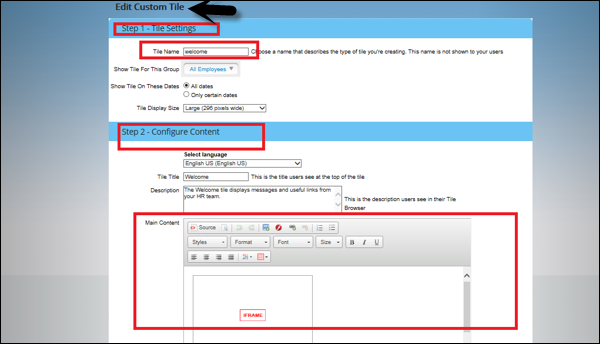Portlet in SuccessFactors refers to the individual sections or containers within the SuccessFactors interface that display specific information or functionalities. These portlets serve as building blocks for the Employee Profile, Dashboard, and other modules, providing users with an organized view of relevant data. Portlets streamline user interactions by grouping related information into easily accessible and manageable sections.
Importance of Portlets in SuccessFactors
Portlets are essential to SuccessFactors because they:
- Simplify navigation by organizing information into logical sections.
- Enable customization, allowing users to add, remove, or modify portlets as needed.
- Enhance user experience by providing targeted insights and quick access to HR data.
- Support modular workflows for HR administrators and employees.
Types of Portlets in SuccessFactors
SuccessFactors offers a variety of portlets catering to different modules and functionalities. Below is an overview:
| Portlet Name | Purpose | Example |
|---|---|---|
| Personal Information | Displays employee details like name, contact info, and address. | Contact Number: +1-234-567-890 |
| Job Information | Shows job-related details, including position, department, and manager. | Position: Senior Analyst |
| Compensation | Provides a summary of salary, bonuses, and other compensation details. | Base Salary: $75,000 |
| Performance Goals | Lists employee goals and their status. | Goal: Complete Project Alpha (80%) |
| Learning Activities | Highlights courses or training assigned to the employee. | Course: Leadership Essentials |
| Employment Details | Displays start date, contract type, and employment status. | Employment Status: Full-Time |
| Time Off | Tracks leave balances and absence history. | PTO Balance: 10 Days |
Key Features of Portlets in SuccessFactors
1. Modular Design
Each portlet is independent, allowing users to view or manage specific data without overwhelming the interface. For example:
- HR administrators can quickly update job information using the Job Information portlet.
- Employees can view their training progress in the Learning Activities portlet.
2. Customization
Users can customize portlets to suit their preferences and organizational needs. Customization options include:
- Adding or removing portlets.
- Rearranging portlet positions on the dashboard.
- Modifying displayed fields based on role-based permissions.
3. Real-Time Data Updates
Portlets dynamically display real-time data from integrated systems, ensuring that users always have access to the most accurate and current information.
4. Interactivity
Portlets allow users to perform actions directly. For instance:
- In the Time Off portlet, employees can request leave.
- In the Performance Goals portlet, managers can update goal progress.
Common Use Cases for Portlets in SuccessFactors
1. Employee Profile
The Employee Profile is made up of several portlets, each showcasing specific information:
- Personal Information Portlet: Allows employees to update their contact details.
- Job Information Portlet: Displays an overview of the employee’s role and reporting structure.
2. Manager Dashboard
Managers benefit from portlets that consolidate team data, such as:
- Team Goals Portlet: Displays the progress of team objectives.
- Compensation Portlet: Summarizes team salary data for budgeting and review.
3. Self-Service HR
Employees can interact with portlets to manage their own HR-related activities:
- Requesting time off through the Time Off Portlet.
- Viewing upcoming training sessions in the Learning Activities Portlet.
Customizing Portlets in SuccessFactors
Steps to Customize a Portlet
- Access the Admin Center:
Navigate to the Admin Center in SuccessFactors. - Select the Relevant Module:
For example, choose Employee Central to customize job or personal information portlets. - Edit the Portlet:

- Add or remove fields.
- Set visibility rules based on roles (e.g., employee vs. manager).
- Rearrange the order of portlets.
- Save Changes:
Once the configuration is complete, save the changes and test the portlet for accuracy.
Benefits of Portlets in SuccessFactors
| Benefit | Description |
|---|---|
| Improved Usability | Modular design ensures users can find information quickly. |
| Customization | Tailored to individual or organizational needs, enhancing relevance. |
| Efficiency | Reduces the time spent navigating through multiple systems. |
| Real-Time Insights | Displays live data, aiding in quick decision-making. |
| Enhanced Interactivity | Allows users to perform actions directly, such as updating details or requesting time off. |
Frequently Asked Questions About Portlets in SuccessFactors
1. Can portlets be role-specific?
Yes, administrators can configure portlets to show or hide information based on a user’s role, ensuring data security and relevance.
2. Are portlets mobile-friendly?
Portlets in SuccessFactors are responsive and accessible via mobile devices, making it convenient for on-the-go users.
3. Can I create custom portlets?
Yes, using the Metadata Framework (MDF), administrators can create custom portlets tailored to organizational needs.
Conclusion
Portlet in SuccessFactors is an essential feature that simplifies HR operations by organizing data into manageable sections. With customizable options, real-time data updates, and interactive functionalities, portlets enhance the overall user experience for both employees and administrators. By leveraging portlets effectively, organizations can streamline workflows, improve data visibility, and empower their workforce.
